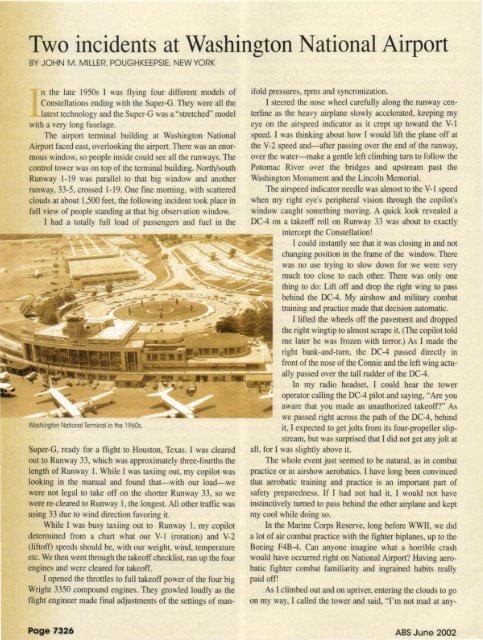Create successful ePaper yourself
Turn your PDF publications into a flip-book with our unique Google optimized e-Paper software.
Two incidents at Washington National AirportBY JOHN M. MILLER. POUGHKEEPSIE, NEW YORK••n the late 1950s I was flying four different models ofConstellations ending with the Super-G. They were all thelatest technology and the Super-G was a "stretched" modelwith a very long fuselage.The airport terminal building at Washington NationalAirport faced east, overlooking the airport. There was an enormouswindow, so people inside could see all the runways. Thecontrol tower was on top of the terminal building. orth/southRunway 1-19 was parallel to that big window and anotherrunway, 33-5, crossed 1-19. One fine morning, with scatteredclouds at about 1,500 feet, the following incident took place infu ll view of people standing at that big observation window.I had a totally full load of passengers and fuel in theWashington Nofional Terminal in the 1960s.Super-G, ready for a flight to Houston, Texas. [ was clearedout to Runway 33, which was approximately three-fourths thelength of Runway I. While I was taxiing out, my copilot waslooking in the manual and found that-with our load-wewere not legal to take off on the shorter Run way 33, so wewere re-cleared to Runway I, the longest. All other traffic wasusing 33 due to wind direction favoring it.While 1 was busy taxiing out to Runway I, my copilotdetermined from a chart what our V-I (rotation) and V-2(liftoff) speeds should be, wi th our weight, wind, temperatureetc. We then went through the takeoff checklist, ran up the fourengines and were cleared for takeoff.I opened the throttles to full takeoff power of the four bigWright 3350 compound engines. They growled loudly as theflight engineer made final adjustments of the settings of man-ifold pressures, rpms and syncronization.I steered the nose wheel carefully along the runway centerlineas the heavy airplane slowly accelerated, keeping myeye on the airspeed indicator as it crept up toward the V-Ispeed. I was thinking about how I would lift the plane off atthe V-2 speed and-after passing over the end of the run way,over the water-make a gentle left climbing turn to follow thePotomac River over the bridges and upstream past theWashington Monument and the Lincoln Memorial.The airspeed indicator needle was almost to the V-I speedwhen my right eye's peripheral vision through the copilot'swindow caught something moving. A quick look revealed aDC-4 on a takeoff roll on Runway 33 was about to exactlyintercept the Constellation!I could instantly see that it was closing in and notchanging position in the frame of the window. Therewas no use trying to slow down for we were verymuch too close to each other. There was only onething to do: Lift off and drop the right wing to passbehind the DC-4. My airshow and military combattraining and practice made that decision automatic .I lifted the wheels off the pavement and droppedthe right wingtip to almost scrape it. (The copilot toldme later he was frozen with terror.) As I made theright bank-and-turn, the DC-4 passed directly infront of the nose of the Connie and the left wing actuallypassed over the tall rudder of the DC-4.[n my radio headset, I could hear the tower• operator calling the DC-4 pilot and saying, "Are youaware that you made an unauthorized takeoff?" Aswe passed right across the path of the DC-4, behindit, I expected to get jolts from its four-propeller slipstream,but was surprised that I did not get any jolt atall, for I was slightly above it.The whole event just seemed to be natural , as in combatpractice or in airshow aerobatics. I have long been convincedthat aerobatic training and practice is an important part ofsafety preparedness. If I had not had it, I would not haveinstinctively turned to pass behind the other airplane and keptmy cool while doing so.In the Marine Corps Reserve, long before WWII, we dida lot of air combat practice with the fighter biplanes, up to theBoeing F4B-4. Can anyone imagine what a horrible crashwould have occurred right on National Airport? Having aerobaticfighter combat familiarity and ingrained habits reallypaid off!As I climbed out and on upriver, entering the clouds to goon my way, I called the tower and said, "[ 'm not mad at any-Page 7326ABS <strong>June</strong> <strong>2002</strong>
















